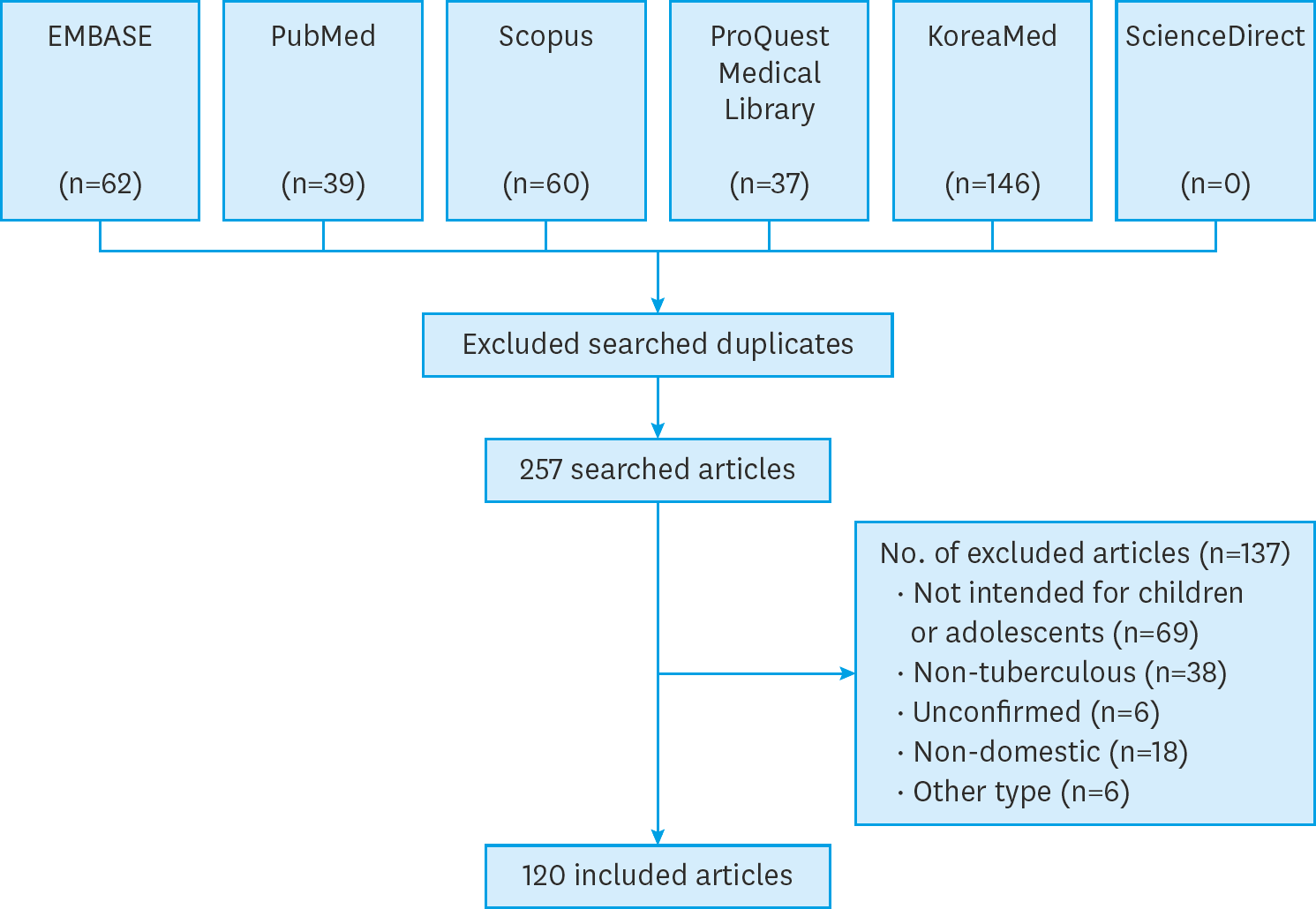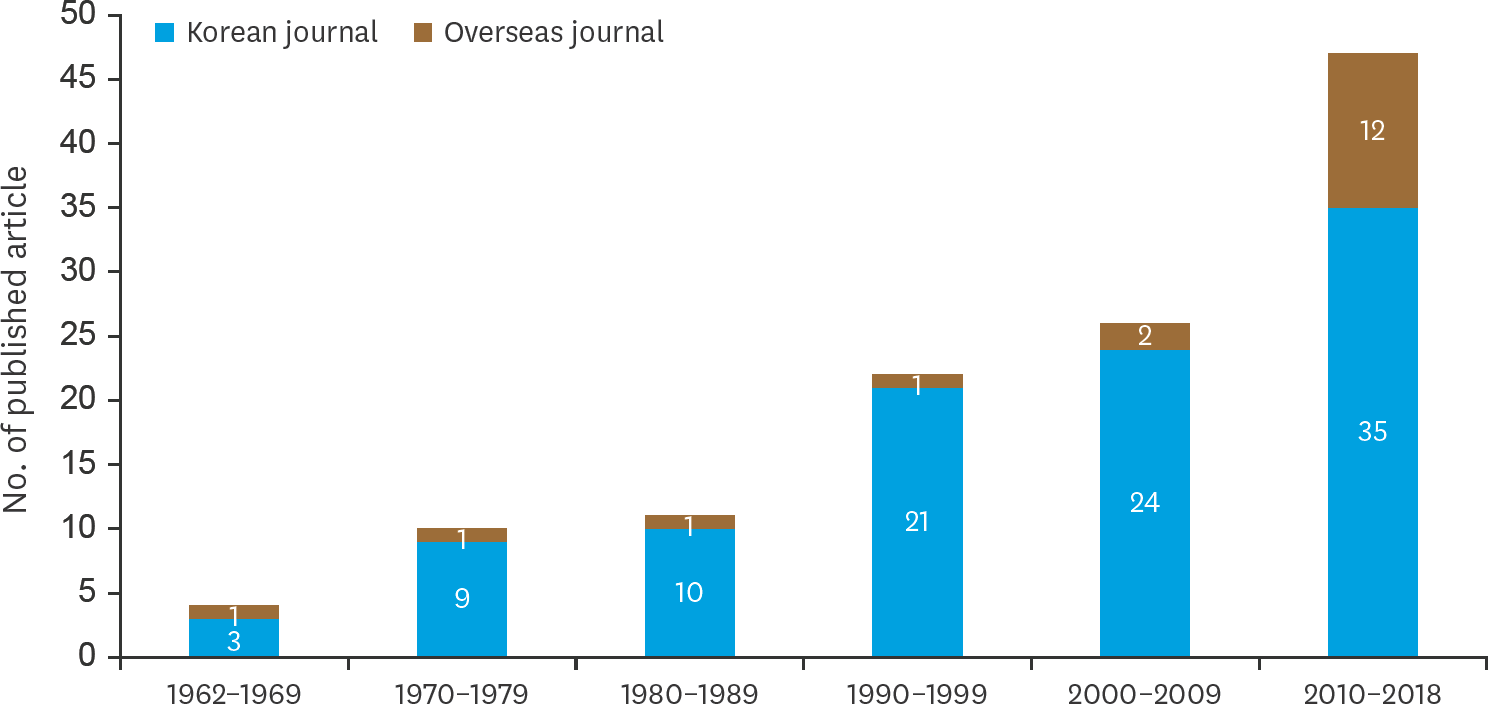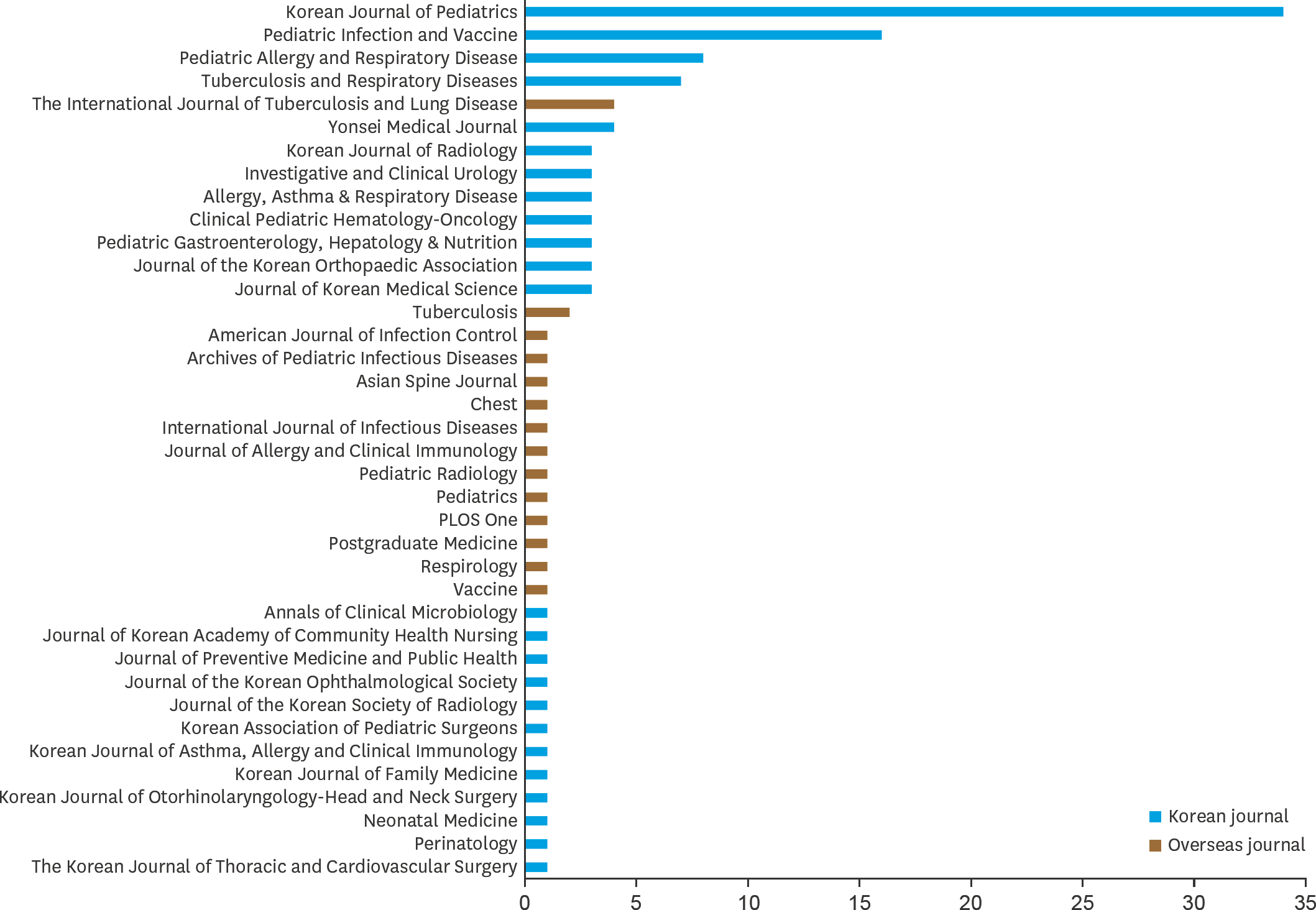Abstract
Purpose
Despite the decline in tuberculosis (TB) incidence and mortality rates in the Republic of Korea through a national TB control program, TB remains one of the most critical infectious diseases in Korean children. We investigated the trends and research areas of published articles on TB in Korean children and adolescents.
Methods
In 6 Korean and overseas databases, we searched titles and abstracts including “tuberculo∗” or “TB,” “child∗” or “adolescen∗” or “neonat∗” or “infant∗” or “pediatric∗,” and “korea∗.” The publication type, publication year, research areas, journal title, and research subjects were analyzed.
Results
Out of the 257 searched documents, 120 papers were included in the analysis. Of these, 82 were original articles (68.3%), 33 case reports (27.5%), 4 review articles (3.3%), and 1 guideline (0.8%). In the original articles, the most common subject of studies was the clinical characteristics of patients with TB (36.6%), followed by diagnostics (29.3%), contact investigations (9.8%), epidemiology (6.1%), treatment (4.9%), vaccine (3.6%), latent TB infection (3.6%), complications (3.6%), and surveys on perception of TB (2.4%). From 1962, 4 articles were published in the 1960s, 10 articles in the 1970s, 11 articles in the 1980s, 22 articles in the 1990s, 26 articles in the 2000s, and 47 articles since 2010.
References
1. World Health Organization. Global tuberculosis report: exclusive summary [Internet]. Geneva: World Health Organization;2018. [cited 2019 Mar 21]. Available from:. https://www.who.int/tb/publications/global_report/tb18_ExecSum_web_4Oct18.pdf.
3. World Health Organization. Roadmap for childhood tuberculosis: towards zero deaths [Internet]. Geneva: World Health Organization;2013. [cited 2019 Mar 21]. Available from:. https://apps.who.int/iris/bitstream/han-dle/10665/89506/9789241506137_eng.pdf.
5. Stop TB Partnership; World Health Organization. An international roadmap for tuberculosis research: towards a world free of tuberculosis [Internet]. Geneva: World Health Organization;2011. [cited 2019 Mar 21]. Available from:. http://www.stoptb.org/assets/documents/resources/publications/technical/tbresearchroadmap.pdf.
6. Kang PS, Lee SK. A study on the effects of BCG vaccination against tuberculosis. Korean J Prev Med. 1982; 15:33–46.
7. Lee H, Cho SN, Kim HJ, Anh YM, Choi JE, Kim CH, et al. Evaluation of cell-mediated immune responses to two BCG vaccination regimes in young children in South Korea. Vaccine. 2011; 29:6564–71.

8. Lee H, Dockrell HM, Kim DR, Floyd S, Oh SY, Lee JB, et al. The current status of BCG vaccination in young children in South Korea. Tuberc Respir Dis (Seoul). 2012; 72:374–80.

9. Schrager LK, Harris RC, Vekemans J. Research and development of new tuberculosis vaccines: a review. F1000Res. 2018; 7:1732.

10. Loxton AG, Knaul JK, Grode L, Gutschmidt A, Meller C, Eisele B, et al. Safety and immunogenicity of the recombinant Mycobacterium bovis BCG vaccine VPM1002 in HIV-unexposed newborn infants in South Africa. Clin Vaccine Immunol. 2017; 24:e00439–16.

11. Scott KM, Lee HK, Ham SS, Park SO, Kim HD, Koh WH, et al. A study of household contacts of cases with pulmonary tuberculosis. Yonsei Med J. 1962; 3:74–8. CROSSREF.

12. Medical Research Council Working Party. A controlled trial of plaster-of-paris jackets in the management of ambulant outpatient treatment of tuberculosis of the spine in children on standard chemotherapy. A study in Pusan, Korea. Second report of the Medical Research Council Working Party on Tuberculosis of the Spine. Tubercle. 1973; 54:261–82.
13. Oh HJ, Yoon HS, Bynn HS, Huh KY, Sohn C. Effects of rifampin (RMP) on liver function in tuberculous children. J Korean Pediatr Soc. 1981; 24:430–6.
14. Lee KS, Park KC, Shin MJ, Kang SC. Rifampin effects on tuberculous meningitis in children. J Korean Pediatr Soc. 1978; 21:543–51.
15. Stop TB Department; Department of Child and Adolescent Health and Development of the World Health Organization. A research agenda for childhood tuberculosis [Internet]. Geneva: World Health Organization;2007. [cited 2019 Mar 22]. Available from:. https://apps.who.int/iris/bitstream/handle/10665/69611/WHO_HTM_TB_2007.381_eng.pdf.
16. Child & Adolescent TB Working Group. Research priorities for paediatric tuberculosis [Internet]. New York, NY: Treatment Action Group;2018. [cited 2019 Mar 22]. Available from:. https://www.finddx.org/wp-content/uploads/2018/09/Paediatric_TB_ResearchPriorities_FINAL_Web.pdf.
17. Bekker A, Schaaf HS, Draper HR, van der Laan L, Murray S, Wiesner L, et al. Pharmacokinetics of rifampin, isoniazid, pyrazinamide, and ethambutol in infants dosed according to revised WHO-recommended treatment guidelines. Antimicrob Agents Chemother. 2016; 60:2171–9.

18. Denti P, Garcia-Prats AJ, Draper HR, Wiesner L, Winckler J, Thee S, et al. Levofloxacin population pharmacokinetics in South African children treated for multidrug-resistant tuberculosis. Antimicrob Agents Chemother. 2018; 62:e01521–17.

19. McIlleron H, Hundt H, Smythe W, Bekker A, Winckler J, van der Laan L, et al. Bioavailability of two licensed paediatric rifampicin suspensions: implications for quality control programmes. Int J Tuberc Lung Dis. 2016; 20:915–9.

20. Garcia-Prats AJ, Draper HR, Finlayson H, Winckler J, Burger A, Fourie B, et al. Clinical and cardiac safety of longterm levofloxacin in children treated for multidrug-resistant tuberculosis. Clin Infect Dis. 2018; 67:1777–80.

22. Swaminathan S, Rekha B. Pediatric tuberculosis: global overview and challenges. Clin Infect Dis. 2010; 50(Suppl 3):S184–94.

23. Zar HJ, Workman L, Isaacs W, Munro J, Black F, Eley B, et al. Rapid molecular diagnosis of pulmonary tuberculosis in children using nasopharyngeal specimens. Clin Infect Dis. 2012; 55:1088–95.

24. Marcy O, Ung V, Goyet S, Borand L, Msellati P, Tejiokem M, et al. Performance of Xpert MTB/RIF and alternative specimen collection methods for the diagnosis of tuberculosis in HIV-infected children. Clin Infect Dis. 2016; 62:1161–8.

25. Walters E, van der Zalm MM, Palmer M, Bosch C, Demers AM, Draper H, et al. Xpert MTB/RIF on stool is useful for the rapid diagnosis of tuberculosis in young children with severe pulmonary disease. Pediatr Infect Dis J. 2017; 36:837–43.

26. LaCourse SM, Cranmer LM, Njuguna IN, Gatimu J, Stern J, Maleche-Obimbo E, et al. Urine tuberculosis lipoarabinomannan predicts mortality in hospitalized human immunodeficiency virus-infected children. Clin Infect Dis. 2018; 66:1798–801.

27. Portevin D, Moukambi F, Clowes P, Bauer A, Chachage M, Ntinginya NE, et al. Assessment of the novel T-cell activation marker-tuberculosis assay for diagnosis of active tuberculosis in children: a prospective proof-of-concept study. Lancet Infect Dis. 2014; 14:931–8.

28. Sweeney TE, Braviak L, Tato CM, Khatri P. Genomewide expression for diagnosis of pulmonary tuberculosis: a multicohort analysis. Lancet Respir Med. 2016; 4:213–24.

Table 1.
Research areas and subject details of 82 original articles




 PDF
PDF ePub
ePub Citation
Citation Print
Print





 XML Download
XML Download